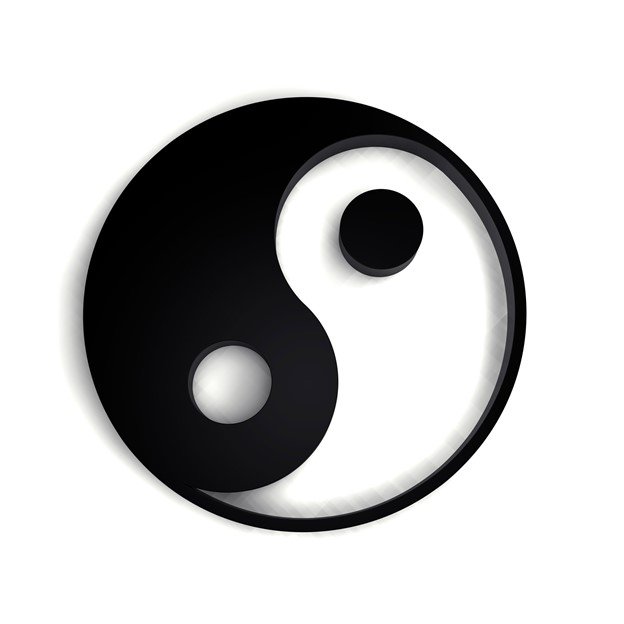The Yin Yang symbol, found in more than one culture, is actually called the Taijitu (or Tai Chi Tu). This symbol literally translates to "Diagram of the Supreme Ultimate". Most people believe that it has roots in Taoism. Yin Yang is a philosophical concept of Chinese origin describing how opposite or contrary forces are actually interconnected, interrelated, and complementary to each other. The duality principle is symbolized by the Yin Yang symbol.
Yin translates to Shady Side, while Yang translates to Sunny Side.
Yin is considered a receptive principle and Yang is considered an active principle. Our aim (or goal if you will) is to keep our Yin and Yang in balance and harmony.
Everything contains both Yin and Yang, however, the ratio of one to the other is never the same. It changes and flows. We, as humans, have both Yin and Yang in us but they are rarely equal nor the same. One day (or moment) you may be more Yin, and at others, more Yang. A man may be considered more Yang overall, but at other times in his life, may become more Yin. The same is true of a woman, who may be either more Yin or Yang. Changes may be due to external or internal forces or circumstances!
We see opposing or contrary forces in all types of change; such as: winter (Yin) versus summer (Yang), north-facing shade (Yin) and south facing brightness (Yang), etc. Other examples of this duality principle (symbolized by Yin and Yang) are manifested physically, including light and dark, fire and water, expanding and contracting, to name just a few.
According to Traditional Chinese Medicine (TCM) Yin or Yang energy flow via the meridians throughout your body. Six of your meridians are primarily Yin (with upward flow) and six are primarily Yang (with downward flow). Yin meridians are predominant in the front of the body; while Yang meridians are predominant in the back of the body. Yin meridians flow into Yang meridians and vice versa. Yin meridians feed Yang organs and Yang meridians feed Yin organs. A Yin meridian is connected to a Yang organ and a Yang meridian connected to a Yin organ.
Yin contains the beginning point for Yang, just like day (light) becomes night (dark). They obviously are interdependent. Neither is static and both change and flow over time. One important thing to remember is that as one (Yin for example) increases, the other (Yang in this case) decreases in order to balance the whole. That being said, due to outside influences, the balance can be skewed where there is deficient or excess of either one. This concept is important in TCM practice.
In the Tai Chi forms, Yin and Yang interplay during the sequence of postures and movements of hands and feet. They must be in harmony! “Yin and Yang transform each other: like an undertow in the ocean, every advance is complemented by a retreat, and every rise transforms into a fall”. Most people are familiar with the Yin/Yang symbol. They have seen it and heard about it but few really understand its true nature.
According to Master Jesse Tsao, PhD, author of Pactical Tai Chi Training - A 9-Stage Method for Mastery, when we root (or settle) prior to taking a step, the rooting is Yin and the stepping is Yang. When practicing Tai Chi form, one hand is often moving away while the other is moving towards your torso. Of course, there are instances where both hands are moving in the same direction (away or towards your torso).
When the hands move downward, this is a Yin motion. Hands moving upwards or rising, is considered a Yang motion.
When your hands move away from your torso, that is a Yang motion. When they move towards your body or torso, that is a Yin motion.
Yin is moving inward or contracting; while Yang is moving outward or expanding.
Yin stepping is backward or withdrawing; while Yang stepping is forward or pushing.
Yin neutralizes; while Yang delivers energy.
Yin is everything inside including the organs, while the skin and surface of the body are Yang.
The lower body corresponds into the Yin, while the upper body corresponds to the Yang.
Yin and Yang meet in the body’s center.
One of my favorite writings by Lao Tzu, the well-known and wise Taoist:
Being and not being create each other
Difficult and not difficult complement each other
Long and short define each other
High and low are opposite to each other
Front and back follow each other
Life (as in Yin and Yang) is always changing and in flux. Our mission (so to speak) is to strive for balance!
Subscribe to receive my weekly blogs in your email.
